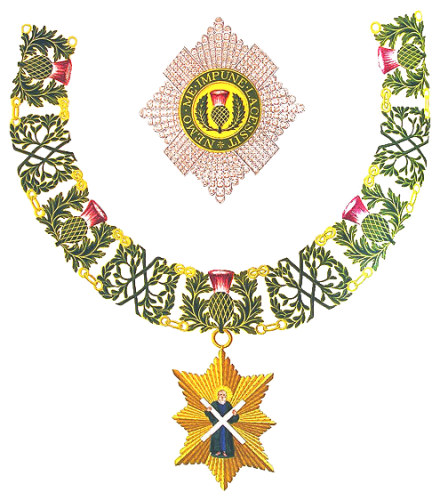You seem to be using an older version of Internet Explorer. This site requires Internet Explorer 8 or higher. Update your browser here today to fully enjoy all the marvels of this site.
June 7, 2018 by Alexander Meldrum
The Order of the Thistle
Is the Most Ancient and Most Noble Order of the Thistle
Insignia of Knight of the Thistle
Awarded by the monarch of Scotland and successor states
The Most Ancient an...The Order of the Thistle
Is the Most Ancient and Most Noble Order of the Thistle
Insignia of Knight of the Thistle
Awarded by the monarch of Scotland and successor states
The Most Ancient and Most Noble Order of the Thistle is an order of chivalry associated with Scotland.
The current version of the Order was founded in 1687 by King James VII of Scotland (James II of England and Ireland) who asserted that he was reviving an earlier Order.
The Order consists of the Sovereign and sixteen Knights and Ladies, as well as certain "extra" knights (members of the British Royal Family and foreign monarchs).
The Sovereign alone grants membership of the Order; he or she is not advised by the Government, as occurs with most other Orders.
The Order's primary emblem is the thistle, the national flower of Scotland.
The motto is Nemo me impune lacessit (Latin for "No one provokes me with impunity").
The same motto appears on the Royal Coat of Arms of the United Kingdom for use in Scotland and some pound coins.
It is also the motto of the Royal Regiment of Scotland, Scots Guards, The Black Watch (Royal Highland Regiment) of Canada and Royal Scots Dragoon Guards. The patron saint of the Order is St Andrew.
Most British orders of chivalry cover the whole United Kingdom, but the three most exalted ones each pertain to one constituent country only.
The Order of the Thistle, which pertains to Scotland, is the second-most senior in precedence. Its equivalent in England, The Most Noble Order of the Garter,
is the oldest documented order of chivalry in the United Kingdom, dating to the middle fourteenth century. In 1783 an Irish equivalent, The Most Illustrious Order of St Patrick, was founded, but has now fallen dormant.
History
James VII claimed that he was reviving an earlier Order, but this issue is marked by widely varying claims.
According to legend, Achaius, King of Scots (possibly coming to the aid of Óengus mac Fergusa, King of the Picts), while engaged in battle at Athelstaneford with the Saxon King Æthelstan of East Anglia, saw in the heavens the cross of St Andrew.
After he won the battle, Achaius is said to have established the Order of the Thistle, dedicating it to the saint, in 786.
The tale is not credible, because the two individuals purported to have fought each other did not even live in the same century.
Another story states that Achaius founded the Order in 809 to commemorate an alliance with the Emperor Charlemagne.
There is some credibility to this story given the fact that Charlemagne did employ Scottish bodyguards.
There is,in addition, a tradition that the order was instituted, or re-instituted, on the battlefield by Robert the Bruce at Bannockburn.
The earliest claim now taken seriously by historians is that James III, who adopted the thistle as the royal plant badge and issued coins depicting thistles, founded the Order during the fifteenth century.
He allegedly conferred membership of the "Order of the Burr or Thissil" on King Francis I of France. However, there is no conclusive evidence for a fifteenth-century order.
A French commentator writing in 1558 described the use of the crowned thistle and the cross of St Andrew on Scottish coins and war banners, and added that there was no Scottish order of knighthood.
Similarly, John Lesley writing around 1578, refers to the three foreign orders of chivalry carved on the gate of James V's Linlithgow Palace with his ornaments of St Andrew, proper to this nation.
Some Scottish order of chivalry may have existed during the sixteenth century, possibly founded by James V and called the Order of St. Andrew, but lapsed by the end of that century.
James VII issued letters patent "reviving and restoring the Order of the Thistle to its full glory, lustre and magnificency" on 29 May 1687.
Although the "restoration" in 1687 of the Most Ancient and Most Noble Order of the Thistle was accomplished by King James VII & II.
The initiative for - essentially - founding this Scottish Royal Order can be attributed to John, 1st Earl and 1st Jacobite Duke of Melfort, then Secretary of State for Scotland,
who together with his elder brother James, 4th Earl and 1st Jacobite Duke of Perth, then Lord Chancellor of Scotland, were among the eight Founding Knights. Eight knights, out of a maximum of twelve, were appointed,
but the King was deposed in 1688.[16] His successors, the joint monarchs William III and Mary II, did not make any further appointments to the Order, which consequently fell into desuetude.In 1703, however,
Anne once again revived the Order of the Thistle, which survives to this day.
Founder knights (restored order)
James, Earl of Perth
George, Duke of Gordon
John, Marquis of Atholl
James, Earl of Arran
Kenneth, Earl of Seaforth
John, Earl of Melfort
George, Earl of Dumbarton
Alexander, Earl of Moray
In this photo:


